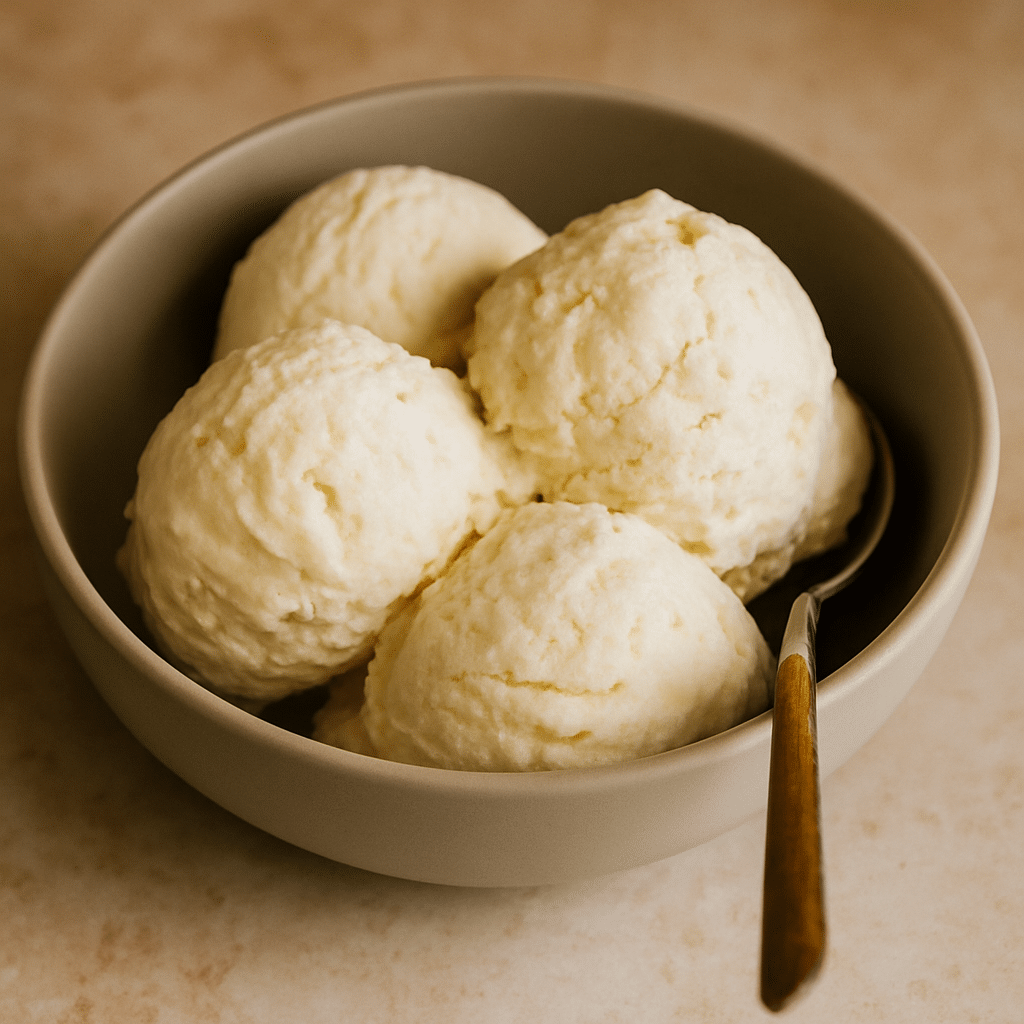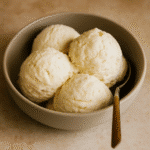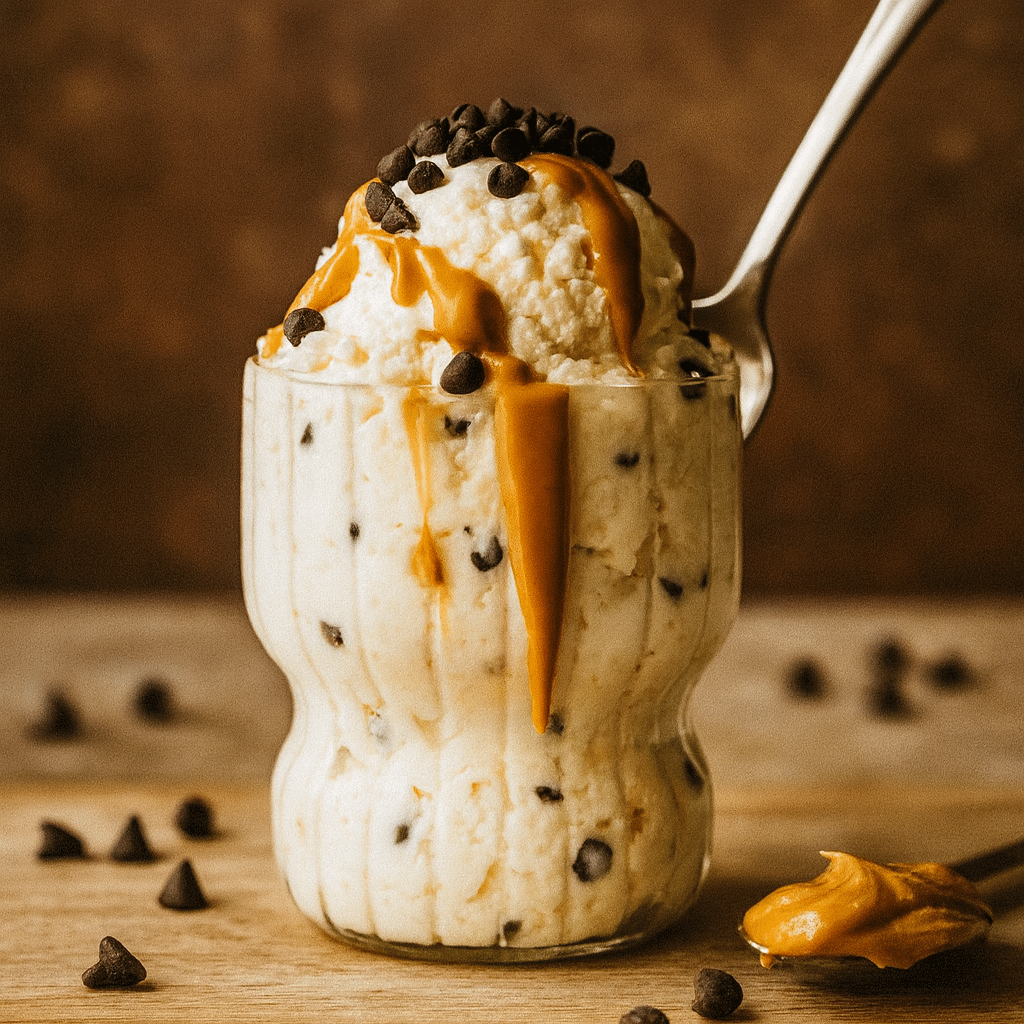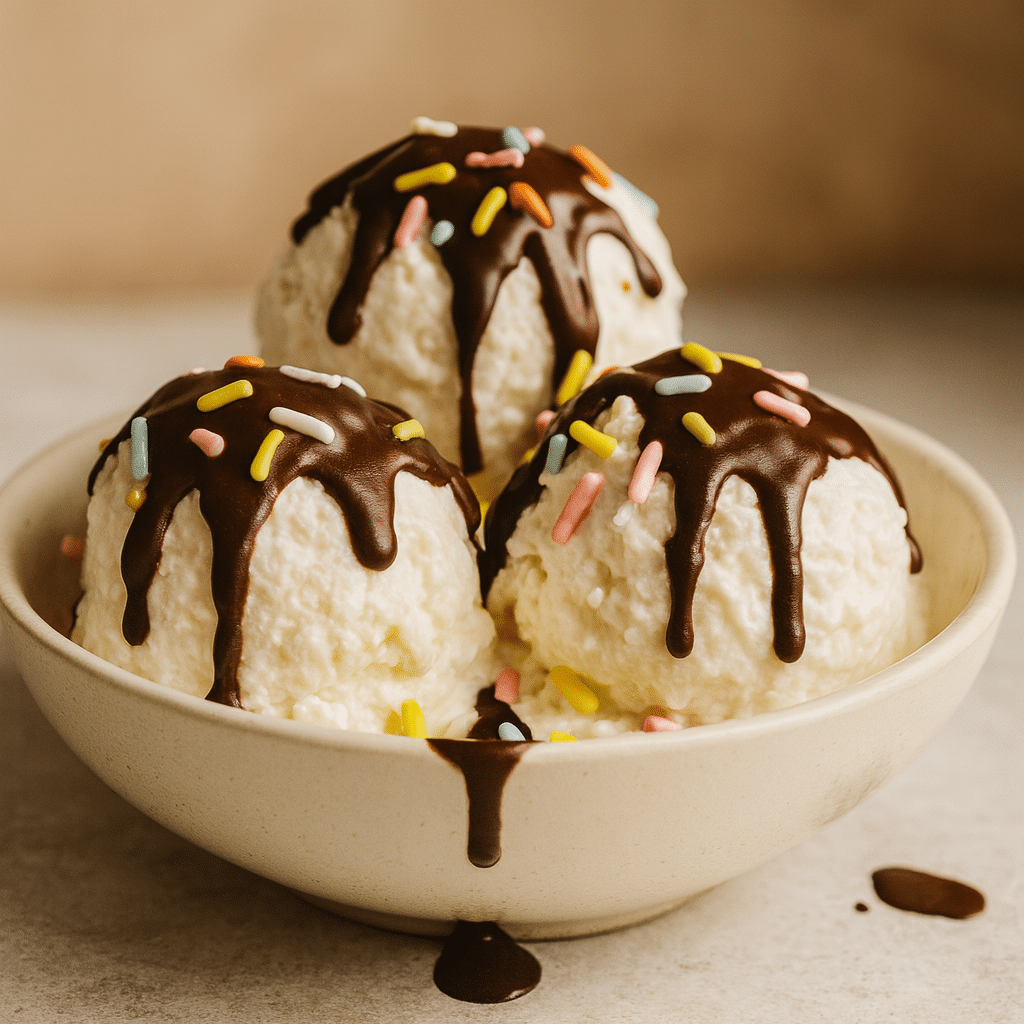Cottage cheese ice cream is the dessert I never expected to love, yet it reminds me of the sweet treats my grandmother used to make with a modern, high-protein twist. Instead of cream and heavy sugar, cottage cheese blends into a smooth base that feels indulgent but supports a healthy lifestyle.

Whether you’ve seen the viral TikTok trend or just want a smarter frozen treat, this guide shows you how to make it creamy, flavorful, and perfect for everyday cravings.
Table of Contents
What Is Cottage Cheese Ice Cream?
A high-protein twist on classic ice cream
Cottage cheese ice cream is made by blending cottage cheese into a smooth base, then freezing it for a creamy dessert. It looks and tastes like real ice cream but with fewer carbs, less sugar, and much more protein.
Why it’s trending online
The recipe went viral because it’s simple, affordable, and healthier than store-bought options. With just cottage cheese, fruit, cocoa, or a natural sweetener, anyone can make it at home in minutes.
How it compares with traditional ice cream
Regular ice cream can reach 250 calories and 20+ grams of sugar per serving, with little protein. The cottage cheese version cuts calories in half and adds up to 15 grams of protein, making it a smarter swap.
💡 Pro Tip: Use a high-speed blender and freeze in a shallow container for the smoothest texture.
Print
Cottage Cheese Ice Cream – Creamy, Protein-Packed & Surprisingly Healthy
- Total Time: 10 minutes (+ freezing time)
- Yield: 2 servings 1x
Description
Cottage cheese ice cream is the creamy, protein-packed frozen dessert that feels indulgent, yet fits perfectly into a health-conscious lifestyle. With just a few ingredients, you get a high-protein treat that’s smooth, customizable, and surprisingly satisfying.
Ingredients
- 1 cup full-fat cottage cheese
- 1–2 tablespoons honey, maple syrup, or monk fruit sweetener
- 1 teaspoon vanilla extract or 2 tablespoons cocoa powder
- Optional: fresh or frozen fruit (e.g. strawberries)
- Optional: nut butter or protein powder for added creaminess
- Optional mix-ins: chocolate chips, crushed cookies, or granola
Instructions
- Add cottage cheese, sweetener, and flavorings to a high-speed blender.
- Blend until completely smooth and creamy.
- Taste the mixture and adjust sweetness or flavor as needed.
- Transfer to a shallow, airtight container.
- Freeze for at least 2–4 hours.
- Let sit at room temperature for 5–10 minutes before scooping.
- Optional: Fold in mix-ins after blending but before freezing.
Notes
For best texture, always use a high-speed blender and freeze in shallow containers. If using a Ninja Creami, freeze the blended base for 24 hours in the Creami pint before spinning.
- Prep Time: 10 minutes
- Cook Time: 0 minutes
- Category: Dessert
- Method: Blended & Frozen
- Cuisine: Modern American
Nutrition
- Serving Size: ½ cup
- Calories: 140
- Sugar: 6g
- Sodium: 280mg
- Fat: 5g
- Saturated Fat: 3g
- Unsaturated Fat: 2g
- Trans Fat: 0g
- Carbohydrates: 8g
- Fiber: 0g
- Protein: 14g
- Cholesterol: 20mg
Why Cottage Cheese Works So Well in Ice Cream
Protein benefits – casein power
Cottage cheese is rich in casein protein, which digests slowly and keeps you full longer. Unlike cream-based ice cream, each scoop brings a steady release of energy and muscle-friendly nutrition.
Lower sugar & healthier fats
Using cottage cheese instead of cream cuts the sugar and saturated fat while adding balance from natural dairy fats. The result is a dessert that feels indulgent without the heavy crash of traditional ice cream.
Gentle on digestion
Many people find cottage cheese easier to digest than heavy cream. It also contains calcium and probiotics, adding an extra health boost you don’t get from most frozen desserts.
💡 Pro Tip: Choose full-fat cottage cheese for creaminess, or low-fat if you want to keep calories lower without losing texture.
👉 For a chocolate version, check out our Chocolate Cottage Cheese Ice Cream recipe.
How to Make Cottage Cheese Ice Cream at Home
Simple 3–5 ingredient base recipe
The easiest version takes just cottage cheese, a sweetener, and your favorite flavor. Blend 1 cup of cottage cheese with 1–2 tablespoons of honey, maple syrup, or monk fruit, plus a splash of vanilla or cocoa powder. Once smooth, freeze it for a few hours, and you’ll have a creamy, high-protein dessert.
Best tools to use
A high-speed blender gives the smoothest base, while a food processor works for thicker results. If you own a Ninja Creami, you can freeze the mixture overnight and spin it for ultra-soft, scoopable texture.
Storage & freezing tips
Always freeze in shallow, airtight containers so the mixture sets evenly. For softer scoops, let the container sit at room temperature for 5–10 minutes before serving. You can also portion into mason jars or silicone molds for grab-and-go servings.
💡 Pro Tip: Taste your mixture before freezing—flavors dull slightly once frozen.
👉 Want fruity inspiration? Try our Strawberry Cottage Cheese Ice Cream.
Popular Flavor Variations
Chocolate cottage cheese ice cream
Blend in 2 tablespoons of cocoa powder or melted dark chocolate for a rich, indulgent flavor. A pinch of sea salt can deepen the taste even more.
Strawberry cottage cheese ice cream
Fresh or frozen strawberries make the base naturally sweet and fruity. Add a touch of vanilla for balance and a scoop of protein powder for extra nutrition.
Peanut butter or banana twist

Mix in a spoonful of peanut butter or half a ripe banana to add creaminess and a dessert-like vibe. Both options turn your ice cream into a satisfying snack.
Creative mix-ins
After blending, fold in chocolate chips, crushed cookies, or granola. This keeps texture balanced and makes every scoop unique.
💡 Pro Tip: Always add mix-ins after blending, not before, to avoid over-processing.
👉 For a refreshing summer version, check out our Strawberry Cottage Cheese Ice Cream.
Cottage Cheese Ice Cream for Special Diets
Keto-friendly option
For anyone following a keto or low-carb lifestyle, cottage cheese ice cream fits naturally into daily macros. By using full-fat cottage cheese and a keto-approved sweetener like monk fruit or stevia, you can create a creamy dessert with only 4–6 net carbs per serving. Add cocoa or nut butter for flavor without the sugar spike. This makes it a smarter swap for traditional keto ice cream brands that often include gums or artificial sweeteners.
High-protein boost
Fitness enthusiasts love cottage cheese ice cream because it can easily be adapted into a post-workout snack. A single serving already packs 12–15 grams of protein, and adding a scoop of whey or plant-based protein powder pushes that number even higher. Combined with the slow-digesting casein from cottage cheese, this version supports recovery and keeps you full longer.
Dairy-friendly adjustments
While cottage cheese is the star, you can still adapt the recipe for different needs. Lactose-free cottage cheese or blended alternatives make the recipe easier on sensitive stomachs. You can also pair the base with almond butter, coconut milk, or even avocado to adjust fat content and flavor. These simple swaps allow the ice cream to fit into dairy-conscious or flexible diets without losing creaminess.
💡 Pro Tip: Always check labels on cottage cheese—many flavored versions contain hidden sugars that don’t align with keto or low-carb goals.
👉 For a detailed low-carb recipe, see our Keto Cottage Cheese Ice Cream.
Ninja Creami Cottage Cheese Ice Cream
Why it went viral
The Ninja Creami turned cottage cheese ice cream into a social media sensation. With just a blended base and a spin cycle, people discovered they could make a creamy, protein-rich dessert at home without heavy cream.
Step-by-step method
Blend cottage cheese with sweetener and flavoring until smooth. Freeze the mix flat in the Creami pint for 24 hours, then use the “Ice Cream” or “Lite Ice Cream” setting. If it looks crumbly, add a splash of milk and re-spin for a soft, scoopable texture.
Fixing texture issues
Crumbly results usually come from under-blending or watery ingredients. Always blend well, freeze fully, and use the re-spin. Adding a spoonful of nut butter or protein powder helps create a thicker, creamier scoop.
💡 Pro Tip: Use official Creami containers for the best results.
👉 See our full guide to Ninja Creami Cottage Cheese Ice Cream.
Nutrition Breakdown – How It Compares with Other Ice Creams
Why nutrition matters in frozen desserts
When choosing ice cream, most people only think about flavor. But if you’re watching calories, sugar, or protein, the differences between traditional ice cream, Greek yogurt ice cream, and cottage cheese ice cream are huge. Understanding the numbers helps you pick the version that matches your lifestyle—whether you want fewer carbs, more protein, or just a balanced sweet treat.
Cottage cheese ice cream vs traditional ice cream
Traditional ice cream is delicious but heavy. A half-cup serving can reach 250–300 calories, packed with 20–30 grams of sugar and 8–12 grams of saturated fat. Protein is low—just 3 to 5 grams. That combination may taste great, but it usually leads to sugar crashes and overindulgence.
Cottage cheese ice cream flips this profile. With the same portion size, you’re looking at 120–150 calories, 5–8 grams of sugar, and 12–15 grams of protein. Fat is lower and more balanced, especially if you use full-fat cottage cheese with nut butter for creaminess. The result? A dessert that supports energy and satiety instead of draining it.
Cottage cheese ice cream vs Greek yogurt ice cream
Greek yogurt ice cream has been popular for years as a healthier alternative. It usually provides 8–10 grams of protein and fewer calories than traditional ice cream. However, it often tastes tangier and freezes harder, which can be off-putting for dessert lovers.
Cottage cheese ice cream, on the other hand, has a neutral flavor that absorbs cocoa, vanilla, or fruit beautifully. With up to 15 grams of protein per serving, it edges out Greek yogurt while keeping a creamier mouthfeel when blended well.
Store-bought “healthy” ice creams vs homemade
Brands like Halo Top, Enlightened, and Arctic Zero have made high-protein ice creams more mainstream. They usually range from 280–380 calories per pint, with 15–20 grams of protein total. While convenient, they often rely on stabilizers, gums, and artificial sweeteners to improve texture and shelf life.
Homemade cottage cheese ice cream gives you full control. You skip the additives and can customize sweetness, flavor, and macros. Plus, per serving, it often outperforms store-bought pints in both nutrition and freshness.
Quick comparison table
| Type (½ cup serving) | Calories | Sugar | Protein | Fat |
|---|---|---|---|---|
| Traditional chocolate ice cream | ~250 | 20–25g | 3–5g | 8–12g |
| Greek yogurt ice cream | ~180 | 12–15g | 8–10g | 5–7g |
| Halo Top (average per ½ cup) | ~160 | 7–10g | 5–6g | 4–6g |
| Cottage cheese ice cream (basic) | ~120 | 5–8g | 12–15g | 3–5g |
Final thoughts on nutrition
If your goal is indulgence with balance, cottage cheese ice cream clearly stands out. It has fewer calories than most frozen desserts, significantly higher protein, and enough versatility to work in keto, high-protein, or low-sugar diets. By making it at home, you know exactly what’s in your scoop and that’s a win for both flavor and health.
💡 Pro Tip: Track your homemade recipe in a nutrition app like MyFitnessPal to see how your mix-ins affect calories and macros.
Common Mistakes & How to Avoid Them
Ice crystals and icy texture
One of the biggest issues is ice crystals forming, which makes the texture hard instead of creamy. This happens when the base is frozen in deep containers or not blended enough.
✅ Fix: Use a high-speed blender and freeze in shallow, airtight containers. Let the ice cream rest at room temperature for a few minutes before scooping.
Too much “cheesy” flavor
Some people find the tang of cottage cheese too strong. Without balance, the flavor can remind you more of dip than dessert.
✅ Fix: Always add vanilla extract or cocoa, and consider nut butter or fruit to smooth out the taste.
Wrong sweeteners
Artificial sweeteners can leave a bitter aftertaste, while too much sugar defeats the purpose of making it healthier.
✅ Fix: Use natural options like monk fruit, maple syrup, or honey, and always taste your mix before freezing.
💡 Pro Tip: Adjust sweetness slightly higher before freezing—flavors dull once frozen.
Cultural Trend & Community Hacks
Viral on TikTok and Instagram

The rise of cottage cheese ice cream started with short TikTok clips showing people blending cottage cheese with fruit or cocoa and then scooping out something that looked just like real ice cream. Viewers were surprised: how could something so simple be so creamy? Within weeks, millions of views turned this recipe into a global healthy dessert trend.
Instagram creators added to the buzz by posting aesthetic bowls topped with granola, berries, and chocolate drizzle. The visual appeal made the recipe even more shareable. What started as a quirky “hack” quickly became a mainstay in fitness and food circles, proving that social media can transform even humble cottage cheese into a star ingredient.
Reddit hacks and community tips
On Reddit, especially in fitness and low-carb subreddits, people took the base recipe and experimented endlessly. Some of the most common tips include:
- Add protein powder for extra post-workout fuel.
- Mix in avocado or nut butter to smooth out texture.
- Use coffee concentrate to create an iced latte–style dessert.
- Freeze flat in smaller jars to reduce ice crystals and make single-serve portions easier.
Users also pointed out that blending well is non-negotiable—any lumps of cottage cheese will freeze into grainy bits. Many recommend investing in a high-speed blender if you plan to make this treat often.
The cottage cheese comeback
For years, cottage cheese had a reputation as “diet food” from the 70s and 80s plain, boring, and not exactly exciting. But now, thanks to creative recipes like cottage cheese ice cream, it’s enjoying a real comeback. Its nutritional profile fits perfectly into today’s health trends: high-protein, low-sugar, and versatile.
Food bloggers and wellness coaches now highlight cottage cheese as a hero ingredient, not just for ice cream but also for pancakes, dips, and cheesecakes. In many ways, the viral trend has rebranded cottage cheese as a modern, functional superfood.
Why the community loves it
What makes cottage cheese ice cream stand out isn’t just nutrition—it’s the fun of customization. Online communities love sharing their unique spins, whether it’s mint chocolate chip with real mint extract or a Snickers-inspired version with dates, cocoa, and peanut butter. This collaborative experimentation keeps the trend alive and ensures there’s always a new twist to try.
💡 Pro Tip: Keep a “flavor notebook” or digital log of your favorite versions. Once you land on a recipe you love, you’ll want to make it again and again.
FAQs About Cottage Cheese Ice Cream
Is cottage cheese ice cream really healthy?
Yes. It’s higher in protein and usually lower in sugar compared to regular ice cream, making it a smart choice for anyone wanting a lighter dessert.
How do you make cottage cheese ice cream?
Blend cottage cheese with a sweetener and your flavor of choice until smooth. Freeze for a few hours, then scoop and enjoy.
Can I replace heavy cream with cottage cheese in ice cream?
You can. Cottage cheese blends into a creamy base without the extra fat and calories from heavy cream.
Does cottage cheese ice cream freeze too hard?
It can, especially if stored in deep containers. For best texture, freeze in shallow jars and let it sit at room temperature for a few minutes before serving.
Can I add protein powder to cottage cheese ice cream?
Absolutely. A scoop of protein powder not only boosts nutrition but also thickens the texture for a richer scoop.
Is cottage cheese good for gut health?
Yes. Cottage cheese provides probiotics and calcium, both of which support digestion and overall wellness.
Conclusion – Why You’ll Love Cottage Cheese Ice Cream
Cottage cheese ice cream is more than a viral recipe—it’s proof that dessert can be both indulgent and nutritious. With just a few simple ingredients, you can enjoy a treat that’s creamy, high in protein, and far lighter than anything in the freezer aisle. From chocolate to strawberry, keto-friendly to Ninja Creami creations, there’s a version for every taste and lifestyle.
The best part? You control the sweetness, the mix-ins, and the portion size, so every batch is tailored to your goals. Once you try it, you’ll see why this recipe has become a favorite for families, fitness lovers, and anyone who enjoys smart comfort food.
👉 For more recipe ideas and inspiration, follow us on Pinterest and Facebook where we share new high-protein desserts every week.
Disclaimer: This article is for informational purposes only and not intended as medical or dietary advice. Nutritional values may vary depending on ingredients and portion sizes. Always consult a healthcare professional if you have specific health concerns or dietary needs.